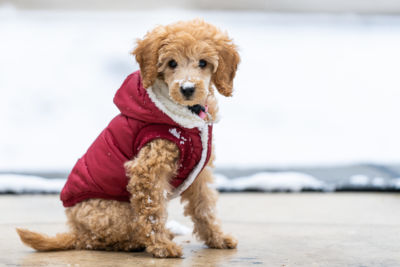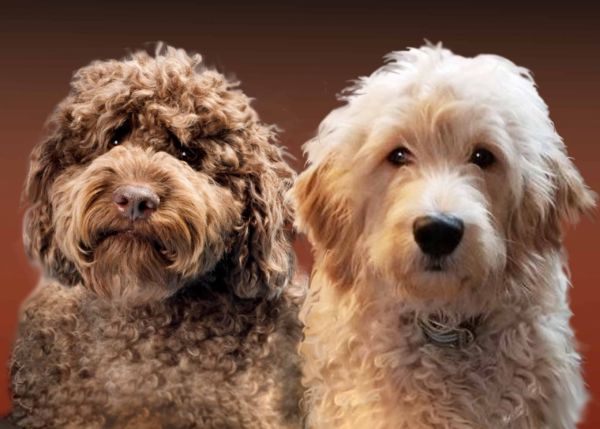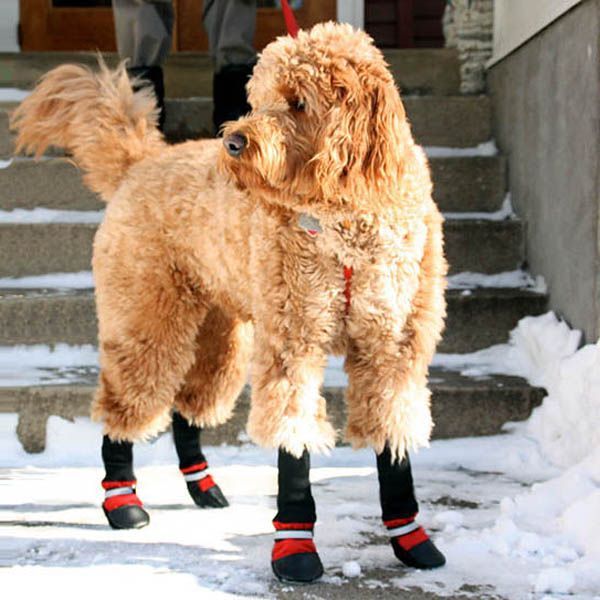
Allergy sufferers are able to experience the joy of owning a dog when they welcome hypoallergenic dogs into their homes.
But how well do labradoodles and goldendoodles fare in colder weather?
Depending on your dog’s age, health conditions and type of coat, you might want to consider purchasing Labradoodle and Goldendoodle coats for rainy and freezing days to keep it nice and warm.
How to Tell If Your Puppy Needs a Coat
The labradoodle breed is a mix between a Labrador retriever and a poodle. This makes labradoodles adventurers that enjoy the outdoors.
Labrador coats aren’t as thick and protective as a retriever’s coat, so they may be at risk when out in the cold. Dogs that are allowed to stay out in the cold for too long can suffer from frostbite and hypothermia, much like humans.
Goldendoodle coats are similar to the labradoodle breed and come in a variety of textures and colors.
The length, texture and color of your dog’s fur all play important parts in whether they need a coat when exposed to inclement weather.
Some dogs are affected by the cold in different ways than others, so make sure you’re paying attention to your dog’s behavior when it’s out in the snow or rain.
If you notice that your puppy runs outside to go to the bathroom and then barrels back to the door to be let inside, it’s not comfortable in the cold at all.
You may also notice that your dog shivers visibly and seeks a source of warmth the moment it gets inside. These are all signs you should buy Labradoodle or Goldendoodle coats for your dog.
Also consider things such as the climate you live in, your dog’s age, any underlying health conditions that can increase cold sensitivity and your dog’s weight.

Age
Younger and older Doodles need Labradoodle and Goldendoodle coats much more as they are more sensitive to cold weather than dogs that are young adults or middle-aged.
The reason younger dogs are affected by the cold is that a puppy coat isn’t yet thick enough to protect against the elements. An adult coat is much thicker and offers more coverage when it’s properly groomed.
Climate
The ideal outdoor temperature for a dog in the fall or winter is around 45 degrees Fahrenheit. Once it gets below this, your puppy will show increasing signs of discomfort in the cold.
If the weather drops below freezing, you should limit the amount of time your dog spends outside, even with the help of Labradoodle and Goldendoodle coats.
Type of Coat
Labradoodle and goldendoodle coats come in a wide range of textures, lengths and varying shades.
Your puppy may have a straight coat, a wavy coat or a curly coat, and it’s possible they’ll have a thick coat that keeps them relatively warm during the winter.
If this is the case, you could actually make your dog uncomfortable by making it wear a coat.
Darker-colored goldendoodle and labradoodle coats absorb heat from the sun, keeping your dog warmer than dogs with lighter and more reflective coats.
Lighter coats don’t retain as much heat, so if your dog’s coat is blonde or golden, you might want to consider buying it a coat.
Weight and Size
The smaller your dog is, the more difficult it is for it to stay warm. Larger dogs retain heat more effectively, so this is another reason a puppy will struggle more in the cold than a dog with an adult coat.
If you have a miniature breed, it’s probably a good idea to buy your dog a coat.
Health Conditions
If your dog has any of the following health conditions, it may be more sensitive to wet or cold weather:
- Diabetes
- Kidney disease
- Heart disease
- Cushing’s disease
- Autoimmune disorders
- Skin conditions
Consult with your veterinarian to understand any changes you need to make to keep your pup safe when it’s ill or recovering from an injury.
Make sure to monitor your puppy more closely in the rain and snow if it’s been diagnosed with a medical condition that could make it more prone to cold-related complications.
Finding the Best Material For Labradoodle and Goldendoodle Coats
There are as many types of Labradoodle and Goldendoodle coats to purchase for your puppy as there are types of puppies to choose from.
Labradoodle and Goldendoodle coats come in an assortment of colors, sizes and thicknesses, so it can be difficult to find one your puppy will feel comfortable in.
The most popular coat types are sheep’s wool coats, fleece coats and coats made of polyester blends.
Wool Coats
Sheep’s wool is extremely warm, so it’s a wonderful material for a puppy coat. It can also be very itchy and difficult to clean, however.
Pay attention if your dog begins to scratch excessively or attempts to escape from the coat. This could be a sign that the wool is irritating their skin or keeping them too warm for comfort.
Blended Coats
Blended Labradoodle and Goldendoodle coats are often made from multiple materials and are ideal due to their water resistance, durability and how easy they are to clean.
They aren’t nearly as warm as wool or fleece, but you can often find coat liners made of alternative materials.
Keeping your puppy dry is as important during cold weather as providing warmth, because freezing temperatures can cause moisture to freeze against your dog’s skin — a common cause of frostbite.
Fleece Coats
Fleece is made from polyester but makes a very warm and soft coat. Normal fleece coats are popular due to their ability to retain heat so well, but fleece is also a popular coat liner.
If you’re looking for a warm coat that won’t irritate your dog’s skin, you can consider a fleece liner inside a wool coat.
It’s also a good idea to carry a fleece-textured coat in case you discover your pup isn’t weathering the cold well.
You can quickly wrap them up in the coat to help restore warmth until you can get them indoors or close to a heat source.
How to Fit Your Goldendoodle or Labradoodle Puppy for a New Coat
It’s important to make sure your puppy’s coat fits snugly without restricting your dog’s movements or making it feel uncomfortable.
Take these measurements using a cloth measuring tape before you start shopping for a coat:
- The distance around your puppy’s collar
- The distance around the widest part of their chest
- The distance from the collar to their tail
When looking for the right fit, it’s also helpful if you’ve weighed your puppy. This helps you find a coat that fits well based on your puppy’s dimensions.
You shouldn’t purchase Labradoodle and Goldendoodle coats without trying it on your dog first. This lets you see how your puppy reacts to the coat.
Even if you find a coat that seems perfect to you, it won’t work if your puppy isn’t comfortable.
It might try to remove or destroy the coat, which could mean the coat is too itchy, too tight or too warm.
What to Avoid When Looking for Labradoodle and Goldendoodle Coats
Consider whether your puppy can chew or swallow any of the components of the jacket.
Buttons, zippers and hooks may seem useful, especially if they provide access to compartments you can use to store objects on walks.
These are potential choking hazards, however, and you should only buy a coat that keeps your pet’s safety in mind.
There are many coat types to choose from. If you search long enough, you’re sure to find a coat that provides the ideal balance of utility and functionality.
Choose a coat based on how you expect it’ll be used.
If you plan on going on trips in the snow, water resistance may be a priority, but if you’re looking for a coat to take your pup on short walks with, it might not be as important as other features.
Don’t Forget Footwear
Your pup’s feet are more exposed to the elements than any other part of their body. With winter weather comes snow, ice, salt and debris that can irritate your puppy’s paws.
If you don’t pay close attention to its feet, it might suffer frostbite or injure itself in the cold. There are two possible solutions to this problem:
Puppy Boots
Water-resistant boots provide warmth to your pup’s feet but also protect them from contaminants and objects that could injure their pads.
It may be difficult to get your puppy to accept the boots at first, but don’t fret.
If you’re unable to get it to tolerate the boots, there’s another solution that works almost as well.

Paw Wax
Paw wax coats your puppy’s pads so that salt, ice and snow don’t come into direct contact. It’s an adequate solution for short trips outside, but you’ll need to reapply the wax often if you plan on being outdoors for an extended period of time.
The Bottom Line
While Labradoodles and Goldendoodles are popular dog breeds for pet owners with dog allergies, keeping their non-shedding coat cut short, might cause them difficulty in colder weather.
If you notice your pup is uncomfortable in the cold, purchasing a coat may help extend its playtime and outdoor adventures without getting hurt.
